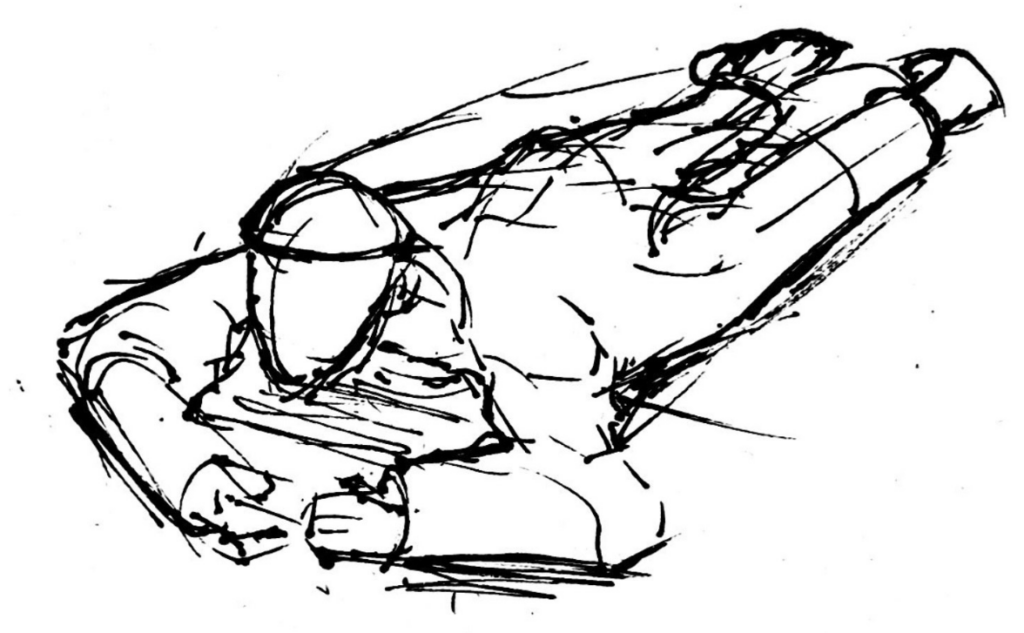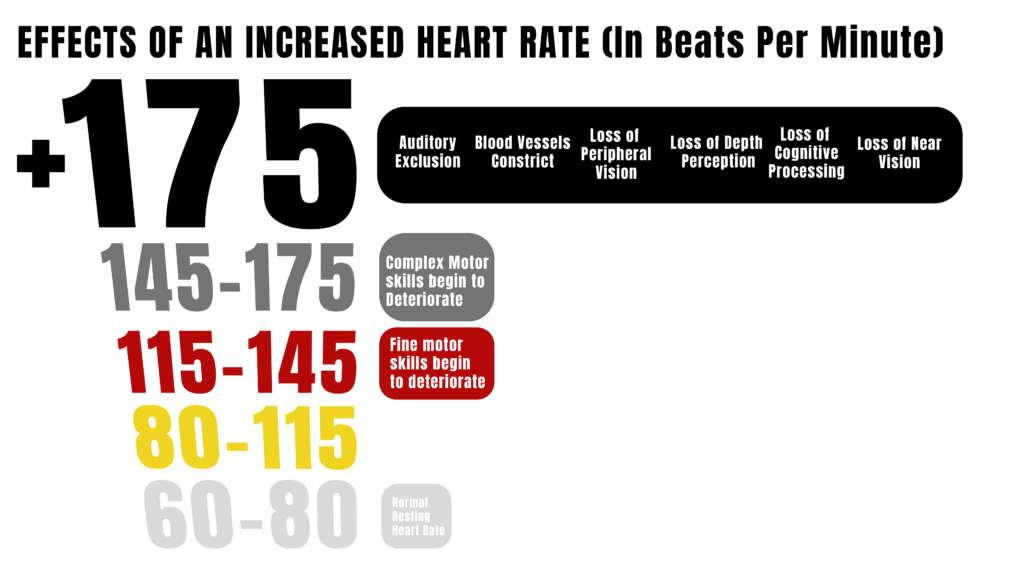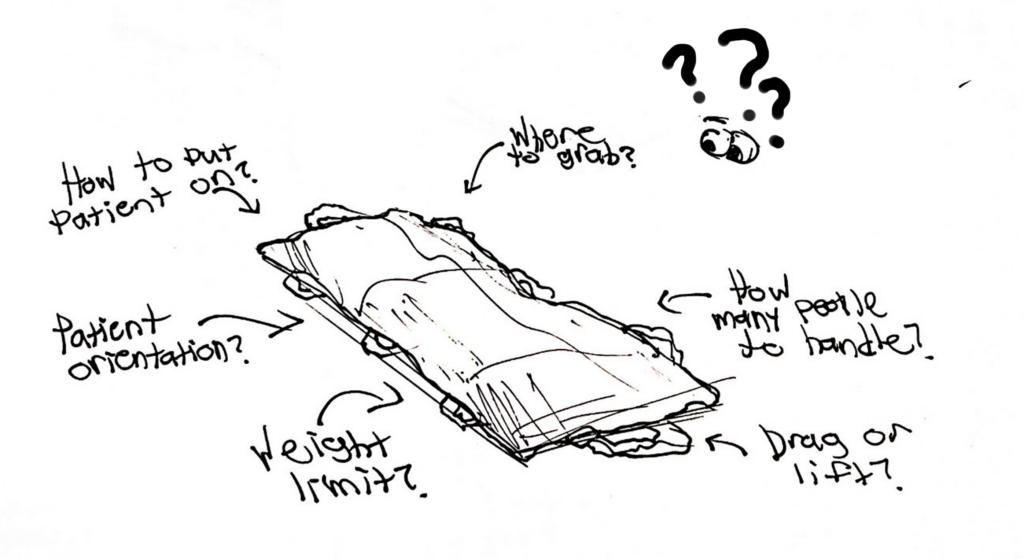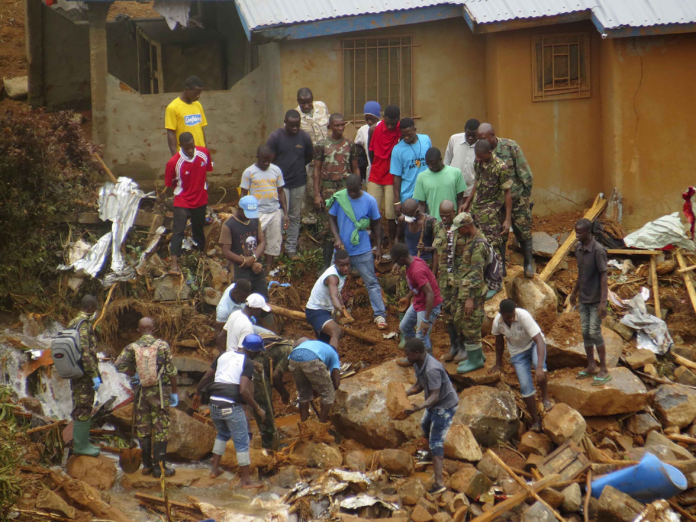Have you ever heard the phrase “Time is Money”? I’d like to go further and say that Time is Life. The more time you waste, the more your life dwindles away. In the macrocosm of life this is true, but in the response to a mass casualty event (such as a tornado, school shooting, earthquake, wildfire, etc). this reality becomes abundantly clear. The National Search and Rescue Plan details, “The life expectancy of an injured survivor decreases as much as 80 percent during the first 24 hours [after a crisis], while the chances of survival of uninjured survivors rapidly diminishes after the first 3 days.”1 Even if the rescue team is already present in the community, it often takes these experts “a minimum of 24 to 48 hours to”… “become operational at a site.”2 So therefore, the individuals already present at the site are paramount to recovery. However, the individual needs to be in the correct mental state to be useful in a response. For example, an individual’s heart rate rises above 115, they begin to lose fine and complex motor skills, peripheral vision and depth perception, cognitive function, and begin exhibiting auditory exclusion.3 Through these symptoms of a larger issue, I’ve come to this conclusion on how to phrase the problem I’ve uncovered:
Given the mental and experiential limitations of those already on the scene, how can we equip the individuals already at or near the scene with extremely intuitive rescue tools in order to supplement search and rescue before and after teams arrive, in order to make rescue and transport more efficient?

Now before talking more on that question, I’d like to break the previously described symptoms down further in detail. The first aspect I’d like to address is what group takes the longest to receive care. When examining a group of injured individuals, victims are classified as mildly injured (green), moderately injured (yellow), severely injured (red), and dead (black).4 Although the severely injured or “red” individuals are the first priority, they’re often the last to arrive to receive care at a hospital.5 This can be due to the fact that severely injured patients can’t walk to receive care themselves (they’re immoble), or due to these individuals being trapped in precarious geographical locations or entrapments. Such as an individual trapped under rubble, locations that are mountainous, high altitude locations, environments with flooding, and any other unique biomes such as a jungle. These individuals are the most at risk, and often the most time sensitive, but are failing to get the care they deserve in an efficient period of time. Once again, the first 24 hours immediately after an incident occurs are absolutely paramount to a successful response.

Rescue teams take 24-48 hours in order to set up to respond to a mass casualty event, and thus miss this critical 24 hour window. So therefore, in the meantime, it’s up to whatever locals and services that happen to already be on scene to handle the situation. Now unfortunately, people aren’t perfect. Not only do individuals lack the expertise and training to deal with a mass casualty incident, but they also may be panicked during the response. When an individual’s heart rate rises above 115, their fine motor skills begin to deteriorate, and at 145 bpm their complex motor skills begin to deteriorate. At 175 bpm higher, an individual starts to exhibit the following symptoms:
- Auditory Exclusion
- Blood Vessels Constrict
- Loss of Depth Perception
- Loss of Peripheral Vision
- Loss of Cognitive Processing
- Loss of Near Vision

On top of these mental deficiencies that may occur, the tools on scene aren’t exactly intuitive anyhow. Even if a person is in a proper state of mind to handle a situation, they may not be able to figure out how to properly utilize tools efficiently. Pictured is my attempt to use a tarp transportation device donated by a division of the Columbus fire station. Questions like which holds to grab, how much weight to hold, how many people should be used for a given amount of weight, were left unanswered by the design of the device itself. If we can’t figure out how to use these devices in a calm and collective environment, it’s not realistic to expect civilians with little to no expertise to properly utilize these devices. Even ignoring the issue of ease of use, these devices simply aren’t built for more challenging and unique environments.
Cases like the recent flood in Libya, and the earthquake in Morocco, show individuals trapped in extremely precarious environments such as under rubble and surrounded by water. Other environments, which have all experienced emergency incidents, such as the jungles of colombia, the california wildfires, the sierra Leone mudslide, and tight corridors like the Virginia Tech shooting all provide unique challenges due to their unique environmental attributes.
The combination of these elements leads to the culmination of our problem statement. First we have the fact that time is of the essence, and knowledge that response within the first 24 hours is the most critical. However, we also realize that rescue teams are often unable to get boots on the ground active for at least 24-48 hours after the event. During the period where rescue teams haven’t arrived yet, it’s up to the individuals there to handle the situation. However, these individuals may not have the mental, experiential, and physical capabilities to properly operate even if they are given tools to do so. In addition, these individuals have to navigate through complex geographic environments.

Through my research, I’ve thought of the search and rescue as a process of five rudimentary components: Search, Extraction, First-aid, transportation, and further care. The omission of a triage step from this process is for the sake of simplicity, due to triage being able to be completed at multiple stages and often completed multiple times in the aftermath of a mass casualty event. I’ll address the difficulty of accomplishing the first four components, in order to provide a clearer picture of the problem statement I’ve previously provided. Please assume the lack of search and rescue teams in the first 24 hours, a lack of expertise in those already on scene, and the natural difficulties of environments like the aforementioned examples.
Search
Search, as I’m defining it, is the seeking of any victims of the mass casualty event regardless of triage level. It’s arguably the most important step, as you can’t help to treat the victims if you can’t find them. The first step of the SALT method (Sort, Assess, Life saving interventions, transport) , which details proper triage and in this case search methods, is to gather the walking wounded in one space.6 This can be accomplished by activating the auditory (If you can walk, come towards me!), visual (beacons of light, or signs), and/or haptic (grabbing an individual’s hand and guiding them) senses of victims. However, these senses can be diminished or eliminated entirely as I realized during a mass casualty simulation at the Columbus airport. Mass casualty incidents can naturally be noisy, provided the sound of firetrucks and other vehicles, mass panic, and the sound of the disaster itself in the case of a natural disaster or shooting. Vision can be impaired due to fog, smoke, dust, vapor, sand, snow, dirt, or even piles of debris blocking a sightline. If you can’t find someone, you can’t grab them. Thus the sense of touch is also eliminated. Finding a way to reach the victim’s senses is the critical component of a successful search, and a large part of our current issue.
Extraction
I’m defining Extraction as removal from any space where an individual may be entrapped. Note that I am not referencing transport over a large area, but simply entrapment. A good example of this would be a victim trapped under rubble, within the flow of a flood, or caught in the area of an active shooter. Before rescue teams arrive, very little tools are often present at a scene. Above is a photo of the recovery of locals after the 2017 mudslide in the country of Sierra Leone.7 They’re using their bare hands to remove rubble, with no tools in sight. Not only does this lack of proper equipment slow down the rescue process, but it also puts more risk for injury on the civilian rescuers, and makes those rescuers fatigued faster.
First Aid
The problem here is simple. If the materials for first aid aren’t available, those who need immediate care will die. Even if first aid materials are provided, the tools may be too unintuitive to figure out given the civilian rescuer’s lack of knowledge or expertise on the subject.
Transportation
As previously discussed, transport can be made difficult when introducing obscure and extreme geography such as mountains, rivers, rubbled terrain, and jungles. However, weather changes, and obviously remoteness can also provide difficulty of transport. Especially considering the athletic ability or lack thereof of civilian rescuers, these elements can cause the transport of victims to arrive for help too late. Thus, tools which adapt through these environments and reduce the physical strain of the transporter are absolutely imperative. However, most transport tools, if present, fail to adapt to complex environments and distances.
Given these struggles, it is absolutely critical to further analyze this scope of problematic in order to capitalize on those first 24 hours after an incident to save as many lives as possible.
- GEN 3.6 Search and Rescue, www.faa.gov/air_traffic/publications/atpubs/aip_html/part1_gen_section_3.6.html#:~:text=According%20to%20the%20National%20Search,after%20the%20first%203%20days.%E2%80%9D. Accessed 19 Sept. 2023. ↩︎
- Holdeman, Eric. “How Many Urban Search and Rescue Teams Do We Have in the U.S.?” GovTech, GovTech, 10 Feb. 2023, www.govtech.com/em/emergency-blogs/disaster-zone/how-many-urban-search-and-rescue-teams-do-we-have-in-the-usa#:~:text=Yes%2C%20there%20are%2028%20funded,up%20of%20approximately%2070%20personnel.
↩︎ - Craig. “Combat Psychology and Sports Performance.” Barefoot Fitness, 26 Feb. 2015, barefootfts.com/combat-psychology-sports-performance/#:~:text=Above%20175%20bpm%20is%20Condition,of%20bowel%20and%20bladder%20control.
↩︎ - “Salt Mass Casualty Triage Algorithm (Sort, Assess, Lifesaving Interventions, Treatment/Transport).” CHEMM, chemm.hhs.gov/salttriage.htm. Accessed 29 Sept. 2023.
↩︎ - Lin, Ming-Wei, et al. “An Innovative Emergency Transportation Scenario for Mass Casualty Incident Management: Lessons Learnt from the Formosa Fun Color Dust Explosion.” Medicine, U.S. National Library of Medicine, 19 Mar. 2021, www.ncbi.nlm.nih.gov/pmc/articles/PMC7982245/.
↩︎ - “Salt Mass Casualty Triage Algorithm (Sort, Assess, Lifesaving Interventions, Treatment/Transport).” CHEMM, chemm.hhs.gov/salttriage.htm. Accessed 29 Sept. 2023.
↩︎ - Busari, Stephanie, and Lauren Said-Moorhouse. “More than 300 Bodies Recovered from Sierra Leone Mudslide.” CNN, Cable News Network, 16 Aug. 2017, www.cnn.com/2017/08/16/africa/sierra-leone-mudslide/index.html.
↩︎




